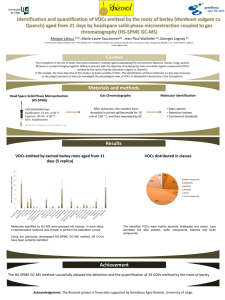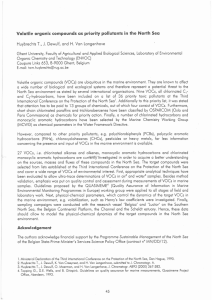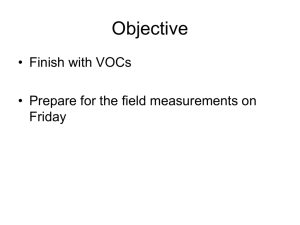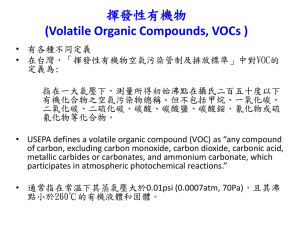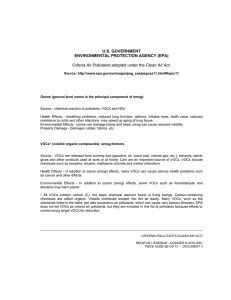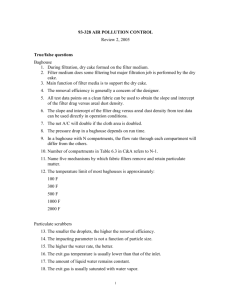2.2 Improved determination of VOCs in marine biota by using... purge and trap—gas chromatography—mass spectrometry'
advertisement
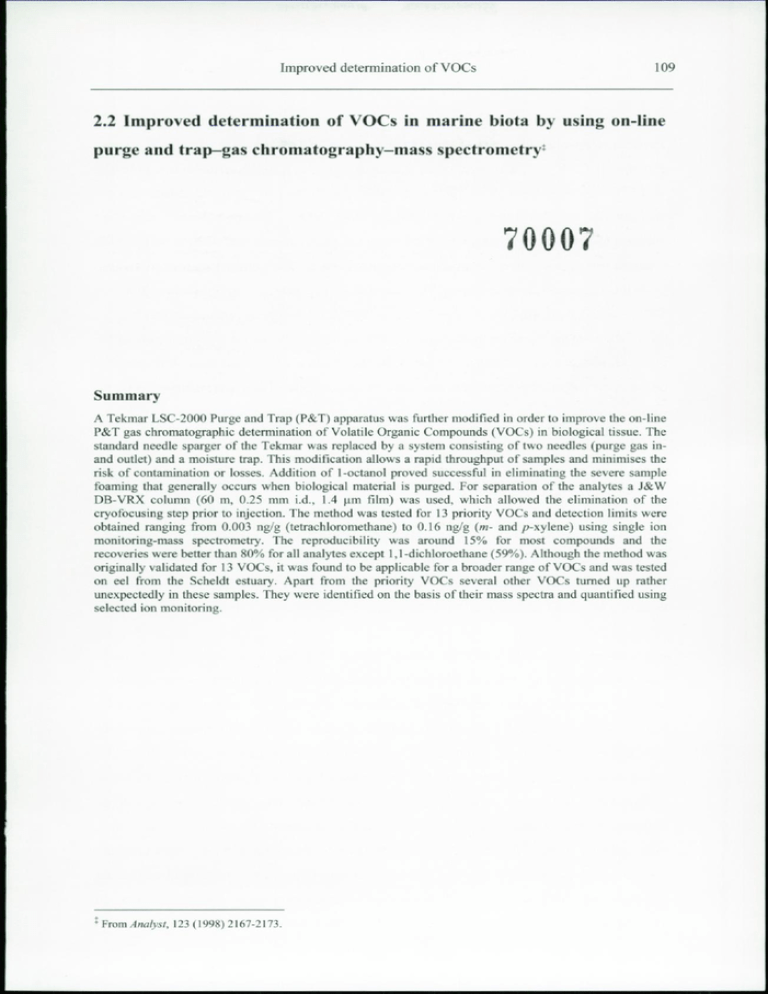
109 Improved determination of VOCs 2.2 Improved determination of VOCs in marine biota by using on-line purge and trap—gas chromatography—mass spectrometry' 70007 Summary A Tekmar LSC-2000 Purge and Trap (P&T) apparatus was further modified in order to improve the on-line P&T gas chromatographic determination of Volatile Organic Compounds (VOCs) in biological tissue. The standard needle sparger of the Tekmar was replaced by a system consisting of two needles (purge gas inand outlet) and a moisture trap. This modification allows a rapid throughput of samples and minimises the risk of contamination or losses. Addition of I -octanol proved successful in eliminating the severe sample foaming that generally occurs when biological material is purged. For separation of the analytes a J&W DB-VRX column (60 m, 0.25 mm i.d., 1.4 µm film) was used, which allowed the elimination of the cryofocusing step prior to injection. The method was tested for 13 priority VOCs and detection limits were obtained ranging from 0.003 ng/g (tetrachloromethane) to 0.16 ng/g (m- and p-xylene) using single ion monitoring-mass spectrometry. The reproducibility was around 15% for most compounds and the recoveries were better than 80% for all analytes except 1,1-dichloroethane (59%). Although the method was originally validated for 13 VOCs, it was found to be applicable for a broader range of VOCs and was tested on eel from the Scheldt estuary. Apart from the priority VOCs several other VOCs turned up rather unexpectedly in these samples. They were identified on the basis of their mass spectra and quantified using selected ion monitoring. From Analyst, 123 (1998) 2167-2173. 110 Analysis 2.2.1 Introduction There is relatively little information on the presence and distribution of volatile organic compounds (VOCs) in marine organisms. This is in part due to the assumed low potential of the VOCs to bioconcentrate [1] and possibly also to the analytical difficulties that are encountered in this type of monito ring. Most VOCs are nonetheless important atmospheric pollutants and a number of them are recognised as compounds with a high research priority by several inte rnational organisations [2-4]. A limited number of authors [5-8] have reported the presence of VOCs in ma rine organisms, some of them as early as 1975. Recent work revealed the presence of VOCs in ma rine organisms at levels at or above those of well-known contaminants such as PCBs [9]. So far, the implications for marine organisms are unknown. As for PCBs the levels are such that there will probably be no acute effects for organisms and man, but the effects of long-term exposure are of some concern. VOCs are determined in organisms using sample-treatment techniques such as solvent extraction [5,8], static headspace[10], vacuum distillation [11-13] and purge and trap (P&T)[ 14-16]. The lowest detection limits are generally reached with those methods that use dynamic headspace techniques (vacuum distillation, P&T). They are less matrix dependent than static headspace techniques and are readily used in combination with gas chromatography-mass spectrometry (GC-MS). Using such an analytical technique detection limits (LODs) better than 100 pg/g have been obtained [9]. In an on-going effort to study the concentrations of VOCs in organisms, a previously reported methodology [9] was further improved. Although the latter was successfully used for the determination of VOCs in organisms, a number of shortcomings gradually became apparent. The P&T set-up was prone to leaking, especially after extended periods of operation. Furthermore, samples had to be exposed to ambient air, although briefly, when sample vials were coupled to the system, which always involves a risk of sample contamination or analyte losses. Even at the low purge flows used, excessive sample foaming sometimes occurred and inevitably resulted in contamination of the system and, consequently, system down time. The current work therefore aims at improving the robustness of the method for use in a more routine environment. The method was tested by exploring the possibility of determining a larger number of VOCs in biota. In anticipation of a planned monitoring programme for yellow eel (Anguilla anguilla), eel Improved determination of VOCs 111 from the Scheldt estuary were used for this purpose. Eel is regarded as an excellent biomonitor for fresh water systems because of its non-migratory behaviour, high fat content, wide distribution and absence of spawning [ 17]. 2.2.2 Experimental Reagents and chemicals All materials used in this study were of research-grade quality. The chlorinated hydrocarbons (CHCs), chloroform, tetrachloromethane, 1,1-dichloroethane, 1,2dichloroethane, 1,1,1-trichloroethane, trichloroethene and tetrachloroethene and the monocyclic aromatic hydrocarbons (MAHs), benzene, toluene, ethylbenzene and the xylenes were all from Merck (Darmstadt, Germany). They were used without further purification. The standard mixture containing the 60 VOCs of EPA method 502.2 was obtained from Alltech (Deerfield, IL, USA). Methanol (Baker, Instra-analysed, Phillipsburg, NJ, USA) was used as solvent for the preparation of standard solutions. 1,1,1-Trifluorotoluene (Ald rich, Milwaukee, WI, USA) was used as internal standard (IS). Vocarb 4000 traps (8.5 cm Carbopack C, 10 cm Carbopack B, 6 cm Carboxen 1000 and 1 cm Carboxen 1001) were obtained from Supelco (Bellefonte, WI, USA) and used as adsorption traps (1/8" OD). Water used for the preparation of blanks and standards was obtained from Baker and 1-octanol used for the reduction of sample foaming was obtained from Merck. Equipment A microprocessor-controlled P&T system, the Tekmar LSC-2000 (Tekmar, Cincinnati, OH, USA), was coupled to a GC-MS (Finnigan Magnum Ion Trap MS, Finnigan, San José, CA, USA) via a heated transfer line terminating in a cryogenic focuser at the GC end. The internal lines of the P&T are constructed from glass-lined stainless steel, and the transfer line and internal lines are connected via a heated 6-po rt switch valve. The standard needle sparger of the Tekmar was replaced with a system consisting of two needles (purge gas in- and outlet) and a moisture trap, which was a 40-ml vial cooled to —10 °C (Figure 2.2.1). The 40-ml open whole screw cap vials (moisture trap and sample vials) and PTFE/silicone liners were obtained from Alltech. 112 Analysis Purge gas 20 mUmin 1/8 ` stainless steel union 1/8 ` teflon tubing Tekmar LSC -2000 Home-made 1/16' Stainless steel needles Sample vial 40 ml Custom-made connector for LSC-2000 Water 15 ml + internal standard Water bath 70°C 40 ml vial cooled at-10°C to condense water vapour Sediment sample ±30g — Cooling mantle Figure 2.2.1: On-line P&T set-up Analytical procedure Preparation of blanks Water specially prepared for the analysis of VOCs (Baker) was used to prepare blanks and standard solutions (see below). Water was continuously purged during storage with nitrogen. For the preparation of blank samples 1 pi of the internal standard was added to 25 ml of the treated water which was then treated as a sample. Preparation of standard solutions A more detailed description of the preparation of standard solutions is given elsewhere [9]. For calibration of the procedure, 1 µl of a methanolic solution containing 0.4-0.8 ng/µl of the various target compounds and 1 µl of a methanolic solution containing the internal standard (about 0.4 ng/µl) were added to 25 ml of blank water (see above). The water was then injected into a 40-ml sample vial, and the sample vial connected to the on-line P&T set-up, pre-concentrated and analysed by GC-MS. The procedure for spiked samples was identical but had an additional settling period of 24 hours. Samples, Sample pre-treatment and analysis Eel, with a length between 20 and 40 cm, were collected in the industrial zone of the Scheldt estuary near Antwerp. Approximately 15 g of muscle tissue from each eel was Improved determination of VOCs 113 homogenised with an Ultra-Turrax blender at 0°C and transferred to a 40-ml sample vial. After the addition of 25 ml organic-free water, 1 Al of the internal standard (1,1,1trifluorotoluene) solution and 20 µl of 1-octanol, the vial was closed with an open hole screw cap with a PFTE-silicone rubber septum and the homogenate treated in a ultrasonic bath (20 min at 0°C) to further disrupt the tissue. The glass vessel was then coupled to the P&T system by puncturing the septum with the two needles. The volatiles were forced out of the sample by purging the sample for 34 min with a 20 ml/min stream of helium at 70°C (water bath). The analytes were trapped onto a Vocarb 4000 sorbent trap mounted in the P&T apparatus at a temperature of 45 °C. After purging, the trap was backflushed while being rapidly heated to 250 °C and the analytes were desorbed into a cryofocusing module connected to the analytical column. The cryofocusing module was either cooled to —120 °C, for an analysis involving cryofocusing, or kept at a constant temperature of 250 °C for an analysis without cryofocusing. The analytes were injected into the GC column by rapidly heating the cryofocusing module from —120°C to 200 °C in 0.75 min or by direct transfer, i.e. without cryofocusing, to the GC column. Separation was done on a 60 m x 0.25 mm ID J&W DBVRX column with a film thickness of 1.4 gm. Temperature programming of the GC and data acquisition were started simultaneously. The temperature of the GC oven was held at 35 °C for 6 min and then linearly increased from 35 °C to 200 °C at 4 °C/min, and finally held at 200 °C for 4 min. Helium was used as the carrier gas with an inlet pressure of 16 psi. The target compounds were identified on the basis of their retention times and m ass spectra and quantified using the total m ass of selected ions (see Table 2.2.1 below). The ion trap detector was operated in the electron ionisation (EI) mode with the multiplier voltage set at 2400 V, the axial modulation (A/M) amplitude at 3.5 V and the emission current at 12 µA. The manifold temperature was set at 220 ° C. The m as s range was 50-250 amu and the scan rate 1000 ms. The filament delay was 180 s, and a m as s defect of 50 mmass / 100 amu and a background mass of 55 amu were selected. Analytical quality assurance A detailed description of the analytical quality assurance is given elsewhere [9]. Blanks were run with each series of samples and compared with previously recorded blanks and the standard solution. Further measures included monitoring the response factors of the standards and treating a standard solution as a sample. 114 Analysis Table 2.2.1: Sequence number, selected ion masses, retention time and LOD (for 40-g sample) for the VOC mixture determined in the eel samples. Compound Trichlorofluoromethane 1,1-Dichloroethene Methylene chloride trans-1,2-Dichloroethene 1,1-Dichloroethane cis 1,2-Dichloroethene 2,2-Dichloroprane Bromochloromethane Chloroform I ,1,1-Trichloroethane Tetrachloromethane Dichloropropene Benzene 1,2-Dichloroethane Trichloroethene 1,2-dichloropropane Dibromomethane Bromodichloromethane Trifluorotoluene cis-1,3-Dichloropropene Toluene trans-1,3-Dichloropropene 1,1,2-Trichloroethane Tetrachloroethene I,3-Tichloropropane Dibromochloromethane 1,2-Dibromoethane Chlorobenzene I , I ,1,2-Tetrachloroethane Ethylbenzene m-Xylene p-Xylene o-Xylene Styrene Bromoform Isopropylbenzene 1,1,2,2-Tetrachloroethane Bromobenzene 1,2,3-Trichloropropane n-Propylbenzene 2-Chlorotoluene 1,3,5-Trimethylbenzene 4-Chlorotoluene tert.-Butylbenzene 1,2,4-Trimethylbenzene sec.-Butylbenzene 1,3-Dichlorobenzene p-Isopropyltoluene 1,4-Dichlorobenzene 1,2-Dichlorobenzene 1,2-Dibromo-3-chloropropane 1,2,4-Trichlorobenzene Hexachlorobutadiene Naphthalene 1,2,3-Trichlorobenzene Sequence number Selected* masses Retention time (min) LOD for (pg/g) 1 2 3 4 5 6 7 8 9 10 11 12 13 14 15 16 17 18 IS 19 20 21 22 23 24 25 26 27 28 29 30 31 32 33 34 35 36 37 38 39 40 41 42 43 44 45 46 47 48 50 51 52 53 54 55 101/103/66 61/63/96 84/86/49 61/96/98 63/83/97 61/96/98 77/79/97 130/128/49 83/85 97/61/99 117/119 39/110/77 78 62/64 130/95/60 62/63/76 174/172/93 83/85/47 146/127/96 75/110/39 91 75/110/39 97/61/99 166/129/94 76/78/41 129/127/48 107/109/27 112/114/77 131/133/95/122 91/105/106 91/105/106 91/105/106 91/105/106 103/78/51 173/171/175 105/125/77 83/85/131/133 158/156/77 75/110/39 91/100/125 91/126 105/125/77 91/126 91/119 77/105/125 134/105 146/111/75 119/91/39 148/146/111/75 146/111/75 157/75/57 180/145/109 260/225/190 128/102 180/145/109 4:13 4:59 5:56 6:26 6:58 8:18 9:03 8:42 8:53 11:15 12:40 12:04 12:57 10:57 16:28 16:08 15:47 16:41 18:24 20:27 24:04 22:45 23:13 27:08 24:23 25:12 26:11 29:58 29:42 31:03 31:55 31:55 33:24 33:08 34:13 34:54 33:21 35:25 33:53 36:35 36:44 37:55 37:03 38:45 39:18 39:36 39:34 40:26 39:52 41:06 43:24 46:59:00 49:14:00 48:46:00 49:29:00 40 6 na = not applicable (IS), * In order of relative abundance 9 7 6 5 7 10 3 8 4 10 1 3 40 20 20 30 na 2 1 2 10 2 9 2 3 1 3 2 1 1 2 2 3 1 6 I 20 2 4 4 6 3 5 20 10 10 10 2 4 90 2 3 9 Improved determination of VOCs 115 2.2.3 Results and discussion Analytical data and methodology The first major modification of our previous P&T procedure [9] was the elimination of the spargers with Wheaton connectors in favour of the system presented in Figure 2.2.1. The spargers were prone to leaking after a period of intensive use, because the PTFE liner of the Wheaton connector deformed at the temperatures and pressure used. Sample vials are now connected to the system simply by puncturing the septa. This connection virtually eliminated the occurrence of leaks during purging. Also, there is no longer any need to open the sample vials in order to connect them to the on-line P&T, which essentially prevents losses due to volatilisation of the analytes and contamination by laboratory air. The la tter is a well known problem in the field of VOC analysis and was thoroughly discussed in our previous work [9]. During this work, both the blank levels, which ranged from 1 to 90 pg/ml, and their variability, which varied between 10 and 120%, were similar to the earlier reported results. In the light of these and previous results contamination during homogenisation and equipment background are still considered to be primary causes of the observed blank levels. The new set-up also uses larger vials, which permit a larger sample intake and, consequently, improve analyte delectability. An additional benefit of the larger vial is the possibility to homogenise the biological tissue in the vial itself, which keeps the sample handling, with all its associated dangers, to a minimum. In earlier studies, sample foaming caused some problems when biological tissues were purged at elevated temperatures [9,18,19]. Contrary to what is reported by Michael et al. [18], addition of 1-octanol totally eliminated sample foaming and allowed an increase of the purge flow to 20 ml/min. A higher flow was impossible due to technical restrictions of the Tekmar P&T, but in an off-line set-up no sample foaming was observed at flows of up to 40 ml/min. Such a higher flow would certainly further decrease the purging time by at least 50% and, consequently, reduce the overall analysis time. This aspect needs to be further investigated. As there were practically no changes in the operational parameters of the original set-up only the purge time for the new volume of 40 ml and purge flow of 20 ml/min was evaluated. Since the two-fold increase in the sample volume was compensated by the twofold increase in purge flow, it was assumed that the o ri ginal purge flow could be 116 Analysis maintained. This was confirmed by a recovery test for those VOCs that are considered priority hazardous compounds [2-4]. The results are given in Table 2.2.2. The recoveries were better than 80% for all analytes except 1,1-dichloroethane (59%), which is the most volatile member of the group. These results are fully satisfactory when compared with the recoveries reported in the literature, which vary from 40 to 130% [11-14,16]. With the original method, the recoveries were between 63 and 115%, however, the variability of the recovery data then was higher. This indicates the increased robustness of the current set-up, a conclusion which is confirmed by the precision data now obtained (Table 2). For ten out of twelve test analytes, the RSD values were 14-17% whereas previously reported repeatabilities varied between 5 and 30% [9,11-14,16]. In summary, the analytical data for the test set are of good quality. Table 2.2.2: Recovery and repeatability data for the target compounds*. Compound Concentration (ng/g) 0.49 Recovery (%) n=5 59 RSD (%; n=5) 17 Chloroform 0.45 88 16 Trichloroethane 0.52 97 17 Tetrachloromethane 0.29 99 17 1,2-Dichloroethane Benzene 0.49 0.29 97 23 Trichloroethene 0.54 95 16 Toluene 0.29 86 17 Tetrachloroethene 0.58 92 15 Ethylbenzene 0.29 82 14 m&p-Xylene 0.42 82 14 o-Xylene 0.39 81 14 1,1-Dichloroethane 92 4.3 * P&T-GC-MS analysis of spiked sample Extending the application range For an exploration of the feasibility of analysing a larger number of VOCs and to determine the separation power of the analytical column, a standard mixture of VOCs had to be chosen that would cover a large number of VOCs with mutually similar physicochemical properties. To this end, the standard mixture of 60 VOCs specified in EPA method 502.2 was selected. Method 502.2 is routinely used for the determination of a large number of volatile organic compounds in drinking water by P&T. A typical GCMS trace of the standard mixture at the concentrations used in this study is shown in Fig. Improved determination of VOCs 117 2.2.2. The current set-up is seen to allow the separation of most VOCs with the exception of m- and p-xylene, o-xylene and 1,1,2,2-tetrachloroethane and sec.-butylbenzene and 1,3-dichlorobenzene. However, o-xylene and 1,1,2,2-tetrachloroethane have totally different mass spectra and the sum of their most prominent peaks (m/z 83,85,131,133 and m/z 91,105,106 respectively) can be used for quantification, while sec.-butylbenzene can be distinguished from 1,3-dichlorobenzene on the basis of m/z 146, 148, 75, 109. Or, in other words, only the m-xylene—plus—p-xylene pair could not be distinguished even when applying selected ion monitoring. 100 _ 45/46 4' 43 32/36 40 41 47 50 35 39 30/31 d 2 20 4 2 15 IS 5 89 16 10 1 13 14 12 22 I 16 19 2 17 18 27 28 24 26 I 54 55 51 33 3I37 I 5 ~ 4 5 7 viU~v~U I I 1 600 10:00 1200 20:00 ' ' v I 1800 30:00 2400 40:00 3000 50:00 Scan number Retention time Figure 2.2.2: Full-scan GC-MS separation of 56 VOCs on a 60 m x 0.25 mm ID J&W DB-VRX column (film 1.4 µm). For details, see Experimental. The use of the long DB-VRX column requires a high inlet pressure. With the normal inlet pressure of 24 psi, a shift of the ion masses with one mass unit was noted and attributed to an insufficient amount of He entering the ion trap. Increasing the inlet pressure to 28 psi indeed solved the problem. The most prominent feature of using the DB-VRX column is that it allows analysis without cryofocusing. This was tested by desorbing the analytes from the trap directly into the analytical column while the cryofocusing module was kept at 250 °C. Figure 2.2.3 clearly shows that eliminating the cryofocusing step has no 118 Analysis influence on the separation, as peak shapes and retention times were not altered at all. Due to a combination of column dimensions, film thickness and oven temperature the analytes were sufficiently focused at the beginning of the column, which makes cryofocusing superfluous. This simplification further improves the robustness of the method, because a constant supply of liquid nitrogen is no longer required. With the previous set-up, the liquid nitrogen supply occasionally became depleted during a run, which resulted in the loss of time as well as sample. Table 2.2.3: VOC detected in eel from the Scheldt estuary and laboratory blanks. Compound Sequence Name number 1 Trichlorofluoromethane VOC levels (ng/g fresh weight) in: Eel I 170 Eel 2 396 Blank level (ng/g) Eel 3 42 nd 15 nd 2 1,1-Dichloroethene nd nd 3 Methylene chloride 8.3 nd nd nd 9 Chloroform 12 4.0 0.15 14 1,2-Dichloroethane 0.39 0.35 0.17 0.004 10 1, I ,1-Trichloroethane 1.6 2.1 1.2 0.005 11 Tetrachloromethane 1.0 1.1 nd 0.006 13 Benzene 2.0 2.4 1.2 0.09 17 Dibromomethane 1.5 1.1 0.74 nd 15 Trichloroethene 6.5 7.7 5.1 nd 22 1,1,2-Trichloroethane 0.53 nd nd nd 20 Toluene 3.8 3.2 1.3 0.06 0.29 0.17 0.09 0.003 82 25 Dibromochloromethane 23 Tetrachloroethene 27 Chlorobenzene 0.34 0.41 0.24 0.01 29 Ethylbenzene 0.71 0.71 0.40 0.04 34 Bromoform 1.2 0.70 0.60 nd m-Xylene & p-xylene 0.92 0.74 0.41 0.03 33 Styrene 1.2 0.54 0.37 nd 32 o-Xylene 1.1 0.99 0.65 0.02 35 Isopropylbenzene 0.42 0.56 0.36 nd 37 Bromobenzene 0.16 0.13 nd 0.008 40 4-Chlorotoluene nd nd 1.3 nd 41 1,2,4-Trimethylbenzene nd 0.33 nd 0.03 46 1,3-Dichlorobenzene 1.6 nd 0.37 0.06 48 1,4-Dichlorobenzene 3.3 0.82 1.7 0.05 50 1,2-Dichlorobenzene 1.6 0.41 0.83 0.03 30/31 nd = below detection limit 15 16 11 0.06 119 Improved determination of VOCs 115 13 1 17 16 A 11 1 L 18 V ■ --- , I I 20:00 16:40 Retention time 15 13 17 B 18 16 i 11 \-/ 16:40 20:i 00 Retention time Figure 2.2.3: Effect of eliminating cryofocusing on performance. (A) With cryofocusing, (B) without cryofocusing. For peak number indentification see Table 2. 120 Analysis The combined results obtained so far indicate that 54 out of the 60 VOCs routinely analysed in water with EPA method 502.2, can be determined in biological tissue using the present procedure. Exceptions are the most volatile compounds, dichlorodifluoromethane, chloromethane, vinylchloride, bromomethane and chloroethane, with boiling points in the —29 to 12 °C range, and n-butylbenzene. Although insufficiency of the present procedure for the volatile compounds is probably a result of the methodology used, this is not the case for n-butylbenzene. The la tter analyte coelutes with an interfering peak that was found to be invariably present in our P&T-GC-MS system and cannot be distinguished from it even with selected ion monitoring. 100— 23 29 ~ ~ 27 3 4 3 32 '' AA ' . ~.NIA ~1` • 1700 20:20 1900 31:40 2100 35:00 seas 4999wr Rewslfe. tI.e 10 13 I 600 10:00 20 ~ 1 1200 20:00 1800 30:00 2400 40:00 3000 50:00 Scan number Retention time Figure 2.2.4: GC-MS chromatogram of eel no. 1 (cf. Table 3) from the Scheldt estuary (box enlarged as insert). For conditions, see Experimental. Improved determination of VOCs 121 Analysis of eel samples Three eel samples from the Scheldt estuary were used to test the practicality of the present approach. Compounds were identified on the basis of their mass spectra and their concentrations were calculated on the basis of selected ion masses. Limits of detection (LODs) were calculated on the basis of a signal-to-noise ratio of 3 or the blank + 3 sd. All relevant data are presented in Table 2.2.2. The results show that all target compounds of Table 2.2.1 except 1,1-dichloroethane were present (Table 2.2.3). Although the majority of the other VOCs (i.e. 15 out of 44) was not detected in any of the samples, several additional VOCs were found such as, e.g. trichlorofluoromethane, brominated methanes, styrene and chlorinated benzenes (Table 2.2.3). As an illustration, a GC-MS trace for eel sample No. 1 is shown in Fig. 2.2.4. The most striking observation is the occurrence of trichlorofluoromethane at concentrations of 40400 ng/g fresh weight, especially since the compound was not detected in the blank so that contamination cannot have played a role. Trichlorofluoromethane or Freon 11 was primarily released to the environment when it was used as an aerosol propellant. Other sources of emission include its use as a refrigerant, foaming agent, solvent and degreaser [1]. The bioconcentration potential of trichlorofluoromethane is assumed to be negligible [1]. Dickson and Riley [6] reported concentrations of trichlorofluoromethane of 0.1-5 ng/g on a d ry weight basis in various marine organisms and 2-20-fold enrichment compared to the water column. The concentrations reported here for eel are much higher, which certainly raises questions about the exposure of the eel to this compound. The brominated compounds found in the eel may well be linked to inadvertent formation during chlorination of drinking water [20]. Helz and Hsu [21] defined transfer from the atmosphere, in situ biosynthesis, in situ chemical synthesis and industrial or municipal waste discharge as the four main ways in which volatile halocarbons are introduced into coastal waters. In this case the latter can be expected to be the predominant source. The presence of chlorinated benzenes is probably due to the various industrial processes in and around the harbour area. Howard [ 1 ] quotes concentrations reported by several authors for fish and seafood, which are generally in the low ng/g range on a fresh weight basis. The present results are of the same order of magnitude. Styrene emissions are typically caused by spillage during production and/or use; styrene is also present in automobile exhausts [1]. However, although the compound is one of the most widely used 122 Analysis raw materials in the polymer industry [22], concentrations comparable to those in Table 2.2.3 have not been reported in the literature. Finally, the average VOC concentrations in eel were compared with the average concentrations in sediment, determined by using the same procedure, and average concentrations for water, covering a period of two years, which were reported by Dewulf et al. [23]. Figure 2.2.5 shows that the concentrations of the target VOCs are several orders of magnitude higher in eel, which again raises questions about the potential to bioconcentrate VOCs and the exposure of fish to these. All compounds discussed during this study are considered to have a low tendency to be bioconcentrated and are therefore not regarded as a potential threat to organisms. Yet during the present and a previous study [9], VOC concentrations occasionally were much higher than what is expected on the basis of their bioconcentration factor (BCF). An overview of calculated and reported BCFs is given in Table 2.2.4. The BCF for chloroform, for instance, is 6 [24], or in other words, concentrations in the organism should be some 6-fold higher than concentrations in the water. Yet the data of Table 2.2.4 show an approx. 100-fold difference. Similarly, the BCFs of tetrachloromethane and toluene calculated from our data are 40-fold and 30fold higher, respectively, than published BCF data. For the other VOCs the discrepancy between published and calculated BCFs is smaller, i.e. 2-10-fold. Moreover, one should consider that for most of the VOCs in Fig. 2.2.5, the concentration levels are comparable 1000 33000 1600 1000 1900 6400 2800 14000 Concentra tion (ng/g wet we ight) 900 800 • Eel 700 D Sediment 600 ❑ Water 500 400 300 200 100 0 ~çe ~~ to~e `o`oe~r G .~ ece e~e ece e~e ece ece d}~~ v`~e~ti ~~~~ ~~pti `o`o¢r ~o~o `o`oe~r `r c e~t <~ Ce ottr ot~r ~~r • 1 'V Figure 2.2.5: Comparison of VOC the concentrations in water, sediment and eel from the same area. Improved determination of VOCs 123 to those of well-known contaminants such as individual CB congeners [25]. The observed levels will probably not cause acute toxic effects, and therefore pose no immediate threat to organisms. The danger lies in the continuous, i.e. long-term, exposure of organisms to low levels of contaminants [21]. Actually, several compounds detected in the organisms are either proven or suspected carcinogens [26]. Table 2.2.4 Comparison between calculated (BCF caic ) and reported bioconcentration factors (BCF 1 ,). BCF L ,t * BCFcaic Compound 6.0 620 Chloroform 8.9 30 Trichloroethane 17 640 Tetrachloromethane 13 95 Benzene 17 150 Trichloroethene 8.3 250 Toluene 49 105 Tetrachloroethene 15 125 Ethylbenzene 15 50 m&p-Xylene 21 85 o-Xylene 2.0 25 1,2-Dichloroethane * Data from references 1.10.24 2.2.4 Conclusion To conclude, the environmental significance of low levels of VOCs in organisms deserves further attention. The present analytical methodology of P&T combined on-line with GCMS can significantly contribute in this field because it provides a robust, sensitive and highly selective way to determine a large range of VOCs in biological tissues. References 1 2 3 4 5 6 7 8 9 P.H. Howard, Handbook of Environmental Fate and Exposure data for Organic Chemicals, Lewis Publishers, Chelsea (USA), 3th edn., 1991. Ministerial Declaration of the 3 rd International Conference on the Protection of the No rth Sea, 7-8 March 1990, The Hague (The Netherlands). Ministerial Declaration of the 4 11' International Conference on the Protection of the No rth Sea, 8-9 June 1995, Esjberg (Denmark). GESAMP (IMO/FAO /Unesco /WMO/IAEA/UN/UNEP Joint Group of experts on the Scientific Aspects of Ma rine Pollution), Review of potentially harmful substances. Choosing priority organochlorines for marine hazard assessment, Food and Agricultural organisation, Rome, Italy, 1990. C.R. Pearson, and G. McConnell, Proc. Royal Soc. Lond B., 189 (1975) 305-332. A.G. Dickson and J.P Riley, Mar. Poll. Bull., 7 (1976) 167-169. J.B. Ferrario, G.C. Lawler, I.R. DeLeon and J.L. Laseter, Bull. Environ. Contam. Toxicol., 34 (1985) 246-255. M. Gotoh, Y. Sekitani, T. Aramaki, H. Kobayashi, K. Ogino and T. Hobara, Bu ll. Environ. Contam. Toxicol., 49 (1992)186-191. P. Roose and, U. A. Th. Brinkman, J. Chromatogr. A., 799 (1998) 233-248. 124 10 11 12 13 14 15 16 17 18 19 20 21 22 23 24 25 26 Analysis M. Ogata, K Fujisawa, Y Ogino and E. Mano, Bull. Environ. Contam. ToxicoL, 33, (1984) 561-567. M.H. Hiatt, Anal. Chem., 53 (1981) 1541-1543. M.H. Hiatt, Anal. Chem., 55 (1983) 506-516. M.H. Hiatt, D.R. Youngman, and J.R. Donnelly, Anal. Chem., 66 (1994) 905-908. D.M. Easley, R.D. Kleopfer and A.M. Carasea, J. Assoc. Off Anal. Chem., 64 (1981) 653. J.B. Ferrario, G.C. Lawler, I.R. DeLeon and J.L. Laseter, Bull. Environ. Contam. Toxicol., 34 (1985) 246-255. K.H. Reinert, J.V Hunter and T. Sabatino, J. Agric. Food Chem., 31 (1983) 1057-1060. J. de Boer and P. Nagel, Sci. Total Environ., 141 (1994) 155-174. L.C. Michael, M.D. Erickson, S.P. Parks and E.D. Pellizzari, Anal. Chem., 52 (1980) 1836-1841. M.E. I4st'; I!N.•Colby, Anal. Chem., 51 (1979) 2176-2180. J.J. Rook, Water Treat. Exam., 23 (1974) 234-243. G.R. Helz and Y. Hsu, Limnol. Oceanogr., 23 (1978) 858-869. C. Pantarotto, M. Salmona, K. Szczawinska and F. Bidoli, in Albaiges, J. (editor), Analytical Techniques in Environmental Chemistry, Pergamon, Oxford, UK, 1980. J. Dewulf, H. Van Langenhove, M. Everaert and H. Vanthournout, Water Research, 32 (1998) 294I2950. P. Isnard and S. Lambe rt, Chemosphere, 17 (1988) 21-34. North Sea Task Force, North Sea Quality Status Report 1993, ed. International Council for the Exploration of the Sea, Oslo and Paris Commissions, London, UK, 1993. G. Holzer and J. Oro, in J. Albaiges (editor), Analytical Techniques in Environmental Chemistry, Pergamon, Oxford, UK, 1980. ate
